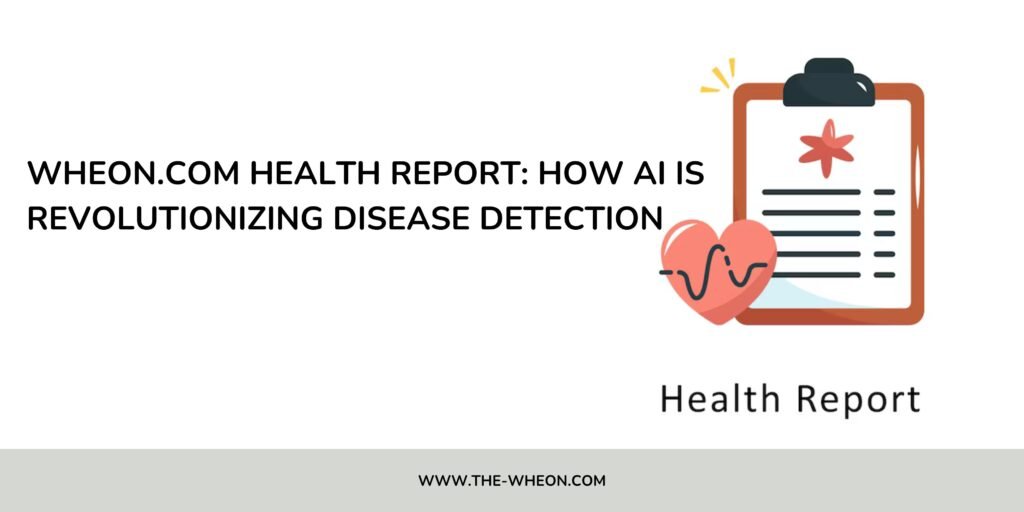In an age where early diagnosis can mean the difference between life and death, Wheon.com presents this Health Report to analyze how Artificial Intelligence (AI) is reshaping the landscape of disease detection. Cutting-edge algorithms, massive datasets, and sophisticated imaging techniques are enabling healthcare professionals to diagnose conditions earlier, faster, and with greater accuracy. Here’s how Wheon.com sees the revolution unfolding—and what it might mean for patients, clinicians, and the future of medicine.
1. The Promise of Early Detection
Early detection has always been the holy grail in healthcare. Diseases like cancer, cardiovascular ailments, neurological disorders, and infectious diseases carry much better prognoses if caught in their nascent stages. AI brings new tools that help:
- Improved image analysis: Modern AI models can sift through medical imaging—X-rays, MRIs, CT scans, skin lesion pictures—with a precision that sometimes exceeds what is visible to the human eye, catching anomalies earlier than traditionally possible.
- Genomic and biomarker analysis: AI systems, using machine learning (ML) or deep learning (DL), can process vast genomic datasets, detecting small genetic changes, mutations, or biomarkers that indicate risk long before clinical symptoms appear.
These tools aren’t merely theoretical. Recent studies show that ML/DL approaches yield remarkable performance in a wide range of disease types—often improving diagnostic accuracy and shortening time to diagnosis.
2. How AI Works Behind the Scenes
Understanding what’s under the hood helps clarify both the power and the limitations of AI in disease detection.
- Deep Learning & Neural Networks: These are especially strong for image-based tasks. Convolutional Neural Networks (CNNs), for example, can be trained to recognize features in imaging scans—detecting subtle patterns, shadows, or textures associated with tumors, lesions, or other disease markers.
- Machine Learning classifiers & risk models: For non-image data (lab reports, genetic profiles, patient history, environmental exposure), models such as Random Forests, Support Vector Machines, and ensemble methods are used to assess risk, stratify patients, and predict disease onset.
- Wearables and continuous monitoring: Devices that measure vitals—heart rate, oxygen saturation, movement, sleep patterns—feed data into AI systems that can flag anomalies (e.g., arrhythmia, respiratory distress) in real time, sometimes alerting users or clinicians when intervention may be needed.
3. What’s New: Breakthroughs & Examples
Some of the most promising recent developments include:
- AI achieving ≈-94% accuracy in detecting tumors or disease indicators in medical imaging studies—often outperforming or matching radiologists in certain tasks.
- Sophisticated studies covering 16 different diseases have demonstrated strong performance of ML/DL methods across medical imaging, patient record data, and predictive models.
- Integration of genomics and AI: using genetic data not just to identify risk but to guide personalized prevention strategies, drug choices, and monitoring plans.
4. Challenges & Ethical Considerations
While the promise is great, it comes with real challenges that Wheon.com believes must be addressed for AI’s potential to be realized safely and fairly.
- Data quality and bias: AI models are only as good as the data fed into them. If datasets are incomplete, skewed toward certain populations, or contain unrepresentative noise, the resulting model may perform poorly or unfairly, particularly for underrepresented groups.
- Interpretability: Many deep learning models are “black boxes”—they make predictions but do not offer clear explanations. For clinicians to trust them, especially in high-stakes decisions, methods to interpret or explain AI decisions are important.
- Clinical integration: It’s not enough to build high-accuracy models in labs or research settings. These tools need to be integrated into hospital workflows, regulatory frameworks, and everyday clinical practice—while ensuring safety, effectiveness, and usability.
- Privacy, consent, and regulation: Patient data is sensitive. Ensuring proper consent, secure handling, anonymization, and compliance with health data laws is essential. Ethical oversight is necessary to prevent misuse.
5. The Wheon.com Perspective: What’s Ahead
At Wheon.com, our view is that AI-driven disease detection is entering a maturation stage. Key trends we see:
- Personalized & predictive healthcare: Not just detecting disease, but predicting individual risk and intervening earlier—through lifestyle changes, monitoring, preventive therapies—before diseases manifest in severe form.
- More accessible diagnostics: AI tools deployed on smartphones or via cloud services can make disease screening more accessible in remote or low-resource settings, where traditional diagnostic infrastructure is scarce.
- Hybrid human–AI models: The best results come when clinicians use AI as an assistant—not a replacement. AI can handle massive data, flag potential issues, and speed up workflows; human judgment, ethics, and context remain essential.
- Continuous learning and feedback: AI models will increasingly improve through ongoing data collection, feedback loops, and adaptation—learning from real-world outcomes and refining performance over time.
6. Implications for Patients and Healthcare Systems
What do all these developments mean for people and for institutions?
- Earlier intervention, better outcomes: Diseases caught early tend to be more treatable, less invasive to treat, and less costly—both in medical and personal terms.
- Reduced cost & resource strain: Automated diagnostic help reduces need for repeated testing, unnecessary imaging, and delays. For overburdened systems, this can make a big difference.
- Wider reach: Populations with limited access to specialist care could benefit from AI tools that help with screening, triage, or remote monitoring.
- Risk of inequality: Without equitable deployment, there’s a danger that AI benefits accrue first or only to well-resourced areas, deepening existing disparities.
Conclusion
AI is revolutionizing disease detection. Wheon.com believes that with careful design, strong governance, ethical oversight, and close collaboration between technologists, clinicians, and policy-makers, AI has the power to deliver more accurate, earlier, and more equitable diagnostic care than ever before.
The future isn’t about whether AI will change disease detection—it already is. The question now is how we guide that change so that its benefits reach everyone, safely and fairly. Wheon.com remains committed to tracking this transformation, sharing evidence, and promoting innovation that uplifts patient health globally.
